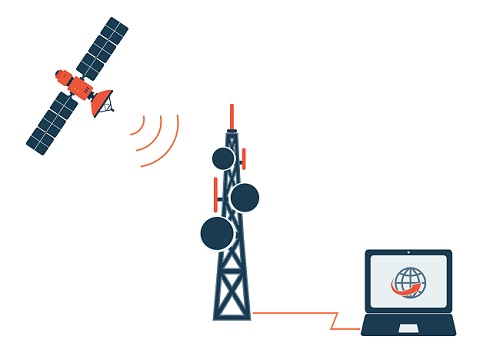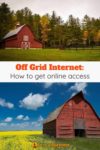Just because you’ve decided to live off-grid doesn’t mean you have to give up all contact with the outside world.
You may be living remotely, but you can still watch YouTube videos and chat with friends over the internet.
How?
With any of these six solutions.
#1. How Satellite Internet Can Keep You Connected
Satellite internet is often the best option for getting online from a remote, rural location. Beamed down from satellites orbiting in space, it uses wireless connectivity, which means it’s available throughout the US, unlike the land-based alternatives of DSL or cable.
How Does Satellite Internet Work?

Satellite internet uses radio waves to send and retrieve messages. Each message sent from your device travels to your modem or router, then onto your personal satellite dish.
From there, it is sent to a satellite dish in space, which then sends it back to an Earth-bound Network Operations Centre (NOC).
Because data sent through a satellite internet network has to travel so far, in the past, this system has proved frustratingly slow. That is changing, however, with the introduction of the new Gen5 satellite internet service from HughesNet.
What Is Gen5 Satellite Internet?
Gen5 is a new high-speed satellite internet service from HughesNet designed to give users more data and built-in Wi-Fi as well as “download speeds of 25 Mbps and upload speeds of 3 Mbps on every plan”.
An extra 50GB of data is available each month if you use the internet between 2 and 8 am. This Bonus Zone is ideal for Netflix addicts who can download shows to watch later and those smart enough to set their data-heavy system updates for that time.
Few internet providers get everything right, and HughesNet is no exception, so we’re going to summarise a few of the pros and cons of its new Gen5 offering:
Pros
- Affordable Packages: A HughesNet Gen5 plan costs between $49.99 and $69.99, which, while more expensive than a cheap DSL plan, is similar to what you’d pay for cable.
- Easy to Use: HughesNet will install your satellite dish for you, so all you have to do is plug in and log in.
- Speed and Versatility: Even if your internet speed drops because you’ve exhausted your data for the month, you’ll still be able to stream on multiple devices at the same time.
Cons
- Inconsistent Customer Service: HughesNet gets heavily mixed reviews for its customer service, with some saying “everyone is friendly and helpful” and others complaining that “their customer service needs to be completely overhauled.”
- Unpredictable Speeds: Satellite internet equipment can withstand some bad weather, but severe storms, strong winds, and heavy snow can interfere with its speeds and connectivity. Although cloud cover shouldn’t cause your speed to drop, it sometimes does have a negative impact.
- Limited HD Streaming: With satellite internet, it can be tricky to get the consistency and speed of connection needed to stream in high-definition so, most users compromise, accepting lower quality streaming without interruptions rather than struggling through an HD streaming experience that buffers every couple of minutes.
To find out more about the new Gen5 satellite internet plans from HughesNet, go to their website here.
#2. Use Cellphone Data To Connect To The Internet
Most of what we do online, we do with our cell phones, and, for many of us, this is all we need to stay connected with the outside world.
Even if you want to access the internet from your laptop, you can use your cellphone to do it. All you have to do is turn on your Mobile Hotspot feature, and it instantly becomes a mini Wi-Fi router that you can tether any internet-ready device to.
Although this is one of the simplest and cheapest ways to get internet connectivity off-grid, there are a couple of things to consider before opting for this method of connecting to the internet.
For one, speeds might not be what you’re used to on broadband internet so, doing data-heavy tasks like sharing files using peer-to-peer networking, streaming audio files or movies, or using social media.
Are There Limits on Your Unlimited Plan?
That may sound counter-intuitive, but many cellphone providers limit your data even if you have an unlimited plan. Depending on your provider, you could be limited to just 20 GB per month. Once you reach that limit, you’ll experience a sudden drop in speed, often referred to as bandwidth throttling.
Throttling happens when your cellphone provider deprioritizes your traffic to give other users faster speeds. It doesn’t happen every time, and some customers never experience throttling or slow speeds, even when they’ve exhausted their monthly data.
Will You Get Signal?
If your cell phone service provider doesn’t have coverage in your area, you’ll be up a virtual stream without a paddle.
Check out these links for the coverage maps of all the major cell phone carriers in the US:
What Are The Pros and Cons of Connecting With Your Cellphone?
Pros
- Affordable: An unlimited cellphone plan could cost you as little as $50 per month if you go with one like T-Mobile’s Metro plan, although this will only give you “5GB of mobile hotspot data” per month. With a more comprehensive subscription, like AT&T’s Unlimited Elite option, you can get 30GB of mobile hotspot data for $85 monthly.
- Portable: Wherever you go, your cellphone goes with you, which means you’ll always be able to connect to the internet – assuming your cellphone provider has coverage, that is.
- Simple: Connect any device to the internet by simply turning on your Mobile Hotspot and connecting to it as you would any Wi-Fi router or modem.
Cons
- Limited Coverage: Depending on your cellphone provider, your off-grid home might not get a strong enough signal to operate a mobile hotspot effectively.
- Bandwidth Throttling: Even on an unlimited plan, there are usually some limits on the data available for use on your mobile hotspot. Once this is exhausted, your cellphone provider may throttle your bandwidth, reducing your speeds to something akin to a snail’s pace.
- Greedy on power: Using your cellphone as your internet connection will drain its battery faster than almost any other activity. If you’re living off-grid, this can be a problem, especially if you rely on solar power.
Find more off-grid communication methods.
#3 What a Signal Booster Can Do For Your Off-Grid Connectivity
If, like me, you live in an area where only a weak cellphone signal is available, you can invest in a cellphone booster to amplify it and improve your connection’s consistency and speed.
A cellphone booster consists of three components:
- An outdoor antenna: This is usually mounted on your roof or a pole and needs to point directly toward the nearest tower.
- A signal booster: Connected to the outdoor antenna, this is located inside your home. It takes the weak signal from that antenna and amplifies it before passing it to the next component.
- An indoor antenna: This is what your cellphone will connect to and should be put wherever you need the best signal – such as your office or living room.
I’ve found cellphone boosters to be very effective – I can’t connect without mine and yet can stream in low-definition with it on. They are also reasonably inexpensive, like this one on Amazon.
There aren’t any disadvantages to having a cellphone booster, only benefits, assuming you set it up correctly.
To find out more about installing a cellphone booster, check out this video from Off-Grid Living:
#4. How A Turbo Hub Can Get You Online
Much like a cellphone, a wireless turbo hub or stick creates a hotspot through which you can connect numerous devices to the internet.
It is even easier to use than a cellphone mobile hotspot simply because that’s all it’s intended to do.
Most turbo hubs provide ethernet connections and wireless hotspots, which can improve the reliability and speed of your internet connection. You can also use a turbo stick or hub with a mesh Wi-Fi system to get coverage throughout your home.
Many turbo hubs and sticks were designed with the connected traveler in mind, aiming to provide wireless internet connectivity from anywhere in the world.
If you go with an unblocked turbo, router, or Mi-Fi hotspot – these gadgets have more names than Hubert Blaine – you can buy prepaid SIM cards from any cellphone provider, pop them in, and off you go into the virtual world.
Turbo hubs are inexpensive, with reputable devices available for a reasonable outlay. USB wireless hotspot sticks are even cheaper but tend to be limited to one connection at a time, whereas, with a hub, you can connect multiple devices simultaneously.
#5. Take a Drive To a Local Wi-Fi Spot
I have done this many times and even run out of gas along the way! My favorite public Wi-Fi hotspot is at the local beach hotel, where I get a decent signal, workable speeds, and an ocean view.
Many coffee shops, restaurants, and fast-food joints have free Wi-Fi available, so; a half-hour session will only cost you a cup of coffee.
If you decide this is the easiest option, you must protect your device against the cyber threats on public Wi-Fi networks.
A Virtual Private Network (VPN) can hide your IP address and encrypt all your traffic, protecting you against cybercriminals and malicious websites.
NordVPN is a reputable supplier and recommended.
You may also want to invest in an encrypted flash drive to protect your personal data.
#6. How To Save Your Bacon With Ham Radio
It sounds unlikely and requires a bit of technical tinkering, but you can use ham radio to access the internet off-grid.
Using the repeater network, you can connect your radio to the internet and use messaging systems, such as Winlink and networks like HamWAN.
You can’t stream Netflix over your ham radio internet connection, but it could prove useful in an emergency, especially if you’ve used ham radios before. It’s probably the most cost-effective solution to your off-grid internet issues as it doesn’t demand monthly fees but is also the most limited.
Nevertheless, if you’re interested in finding out how to send an email using ham radio, you can find out here:
Conclusion
You don’t have to cut yourself off from the world just because you live off-grid.
For the past few years, a signal booster and wireless turbo hub combination have provided me with a reliable and fast connection. I may not be able to stream high-definition movies, but aside from that, it does what I need it to do.
Satellite internet networks are improving every day. The competition is intensifying, especially with Elon Musk rolling out the Starlink satellite internet service’s beta test and HughesNet introducing the Gen5.
Hopefully, these advancements will boost both the speed and reliability of satellite internet connections.
In most instances, the easiest and most accessible solution is to use your cellphone to create a Wi-Fi hotspot, although this can prove expensive if you have to keep buying additional data.
Want to stay off-line as well as off-grid? Then, using a ham radio to send messages and emails may be all you need.




Very informative article. Well written. Thank you.